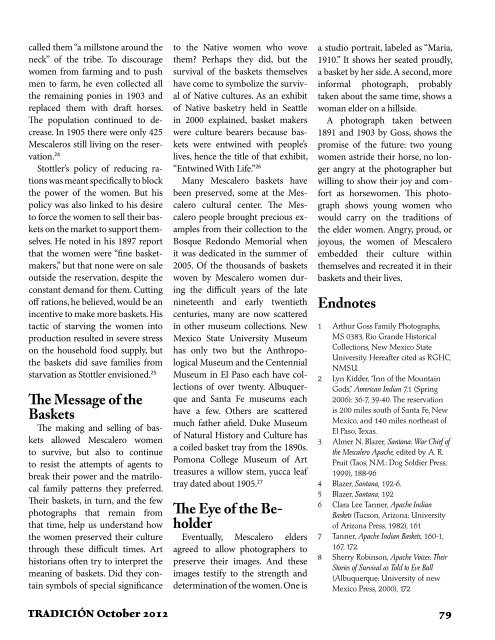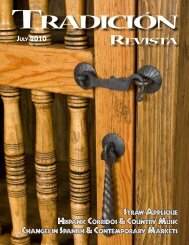tradicion revista fall 2012 - LPD Press & Rio Grande Books
tradicion revista fall 2012 - LPD Press & Rio Grande Books
tradicion revista fall 2012 - LPD Press & Rio Grande Books
Create successful ePaper yourself
Turn your PDF publications into a flip-book with our unique Google optimized e-Paper software.
called them “a millstone around the<br />
neck” of the tribe. To discourage<br />
women from farming and to push<br />
men to farm, he even collected all<br />
the remaining ponies in 1903 and<br />
replaced them with draft horses.<br />
The population continued to decrease.<br />
In 1905 there were only 425<br />
Mescaleros still living on the reservation.<br />
24<br />
Stottler’s policy of reducing rations<br />
was meant specifically to block<br />
the power of the women. But his<br />
policy was also linked to his desire<br />
to force the women to sell their baskets<br />
on the market to support themselves.<br />
He noted in his 1897 report<br />
that the women were “fine basketmakers,”<br />
but that none were on sale<br />
outside the reservation, despite the<br />
constant demand for them. Cutting<br />
off rations, he believed, would be an<br />
incentive to make more baskets. His<br />
tactic of starving the women into<br />
production resulted in severe stress<br />
on the household food supply, but<br />
the baskets did save families from<br />
starvation as Stottler envisioned. 25<br />
The Message of the<br />
Baskets<br />
The making and selling of baskets<br />
allowed Mescalero women<br />
to survive, but also to continue<br />
to resist the attempts of agents to<br />
break their power and the matrilocal<br />
family patterns they preferred.<br />
Their baskets, in turn, and the few<br />
photographs that remain from<br />
that time, help us understand how<br />
the women preserved their culture<br />
through these difficult times. Art<br />
historians often try to interpret the<br />
meaning of baskets. Did they contain<br />
symbols of special significance<br />
to the Native women who wove<br />
them? Perhaps they did, but the<br />
survival of the baskets themselves<br />
have come to symbolize the survival<br />
of Native cultures. As an exhibit<br />
of Native basketry held in Seattle<br />
in 2000 explained, basket makers<br />
were culture bearers because baskets<br />
were entwined with people’s<br />
lives, hence the title of that exhibit,<br />
“Entwined With Life.” 26<br />
Many Mescalero baskets have<br />
been preserved, some at the Mescalero<br />
cultural center. The Mescalero<br />
people brought precious examples<br />
from their collection to the<br />
Bosque Redondo Memorial when<br />
it was dedicated in the summer of<br />
2005. Of the thousands of baskets<br />
woven by Mescalero women during<br />
the difficult years of the late<br />
nineteenth and early twentieth<br />
centuries, many are now scattered<br />
in other museum collections. New<br />
Mexico State University Museum<br />
has only two but the Anthropological<br />
Museum and the Centennial<br />
Museum in El Paso each have collections<br />
of over twenty. Albuquerque<br />
and Santa Fe museums each<br />
have a few. Others are scattered<br />
much father afield. Duke Museum<br />
of Natural History and Culture has<br />
a coiled basket tray from the 1890s.<br />
Pomona College Museum of Art<br />
treasures a willow stem, yucca leaf<br />
tray dated about 1905. 27<br />
The Eye of the Beholder<br />
Eventually, Mescalero elders<br />
agreed to allow photographers to<br />
preserve their images. And these<br />
images testify to the strength and<br />
determination of the women. One is<br />
a studio portrait, labeled as “Maria,<br />
1910.” It shows her seated proudly,<br />
a basket by her side. A second, more<br />
informal photograph, probably<br />
taken about the same time, shows a<br />
woman elder on a hillside.<br />
A photograph taken between<br />
1891 and 1903 by Goss, shows the<br />
promise of the future: two young<br />
women astride their horse, no longer<br />
angry at the photographer but<br />
willing to show their joy and comfort<br />
as horsewomen. This photograph<br />
shows young women who<br />
would carry on the traditions of<br />
the elder women. Angry, proud, or<br />
joyous, the women of Mescalero<br />
embedded their culture within<br />
themselves and recreated it in their<br />
baskets and their lives.<br />
Endnotes<br />
1 Arthur Goss Family Photographs,<br />
MS 0383, <strong>Rio</strong> <strong>Grande</strong> Historical<br />
Collections, New Mexico State<br />
University. Hereafter cited as RGHC,<br />
NMSU.<br />
2 Lyn Kidder, “Inn of the Mountain<br />
Gods,” American Indian 7.1 (Spring<br />
2006): 36-7, 39-40. The reservation<br />
is 200 miles south of Santa Fe, New<br />
Mexico, and 140 miles northeast of<br />
El Paso, Texas.<br />
3 Almer N. Blazer, Santana: War Chief of<br />
the Mescalero Apache, edited by A. R.<br />
Pruit (Taos, N.M.: Dog Soldier <strong>Press</strong>,<br />
1999), 188-96<br />
4 Blazer, Santana, 192-6.<br />
5 Blazer, Santana, 192<br />
6 Clara Lee Tanner, Apache Indian<br />
Baskets (Tucson, Arizona: University<br />
of Arizona <strong>Press</strong>, 1982), 161<br />
7 Tanner, Apache Indian Baskets, 160-1,<br />
167, 172.<br />
8 Sherry Robinson, Apache Voices: Their<br />
Stories of Survival as Told to Eve Ball<br />
(Albuquerque: University of new<br />
Mexico <strong>Press</strong>, 2000), 172<br />
TRADICIÓN October <strong>2012</strong> 79




